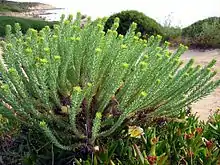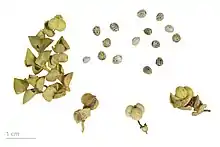Euphorbia paralias
Euphorbia paralias, the sea spurge, is a species of Euphorbia, native to Europe, northern Africa, and western Asia.[1]
| Euphorbia paralias | |
|---|---|
 | |
| Sea Spurge in La Revellata, Corsica | |
| Scientific classification | |
| Kingdom: | Plantae |
| Clade: | Tracheophytes |
| Clade: | Angiosperms |
| Clade: | Eudicots |
| Clade: | Rosids |
| Order: | Malpighiales |
| Family: | Euphorbiaceae |
| Genus: | Euphorbia |
| Species: | E. paralias |
| Binomial name | |
| Euphorbia paralias | |
The species is widely naturalised in Australia.[2] It invades coastal areas, displacing local species and colonising open sand areas favoured by certain nesting birds.[3] Major eradication programmes have been undertaken in some areas, for example by Sea Spurge Remote Area Teams in Tasmania, with great success.[4]
Description
It is an erect, glaucous, perennial plant growing up to 70 cm tall. The plant has many stems, dividing into 3-5 fertile branches, each branching further. The cauline leaves (arising from the stem, without stalk) are crowded, overlapping, elliptic-ovate (ovate toward the top of the stems), fleshy and 5 to 20 mm long. Leaves on fertile branches are circular-rhombic or reniform. Flower head on a solitary cyathia, found in upper forks or at the apex, surrounded by bell-shaped bracts. Female flowers are with styles that divide into two short stigmas, flowering September-May. Fruit is a capsule flattened from above or nearly spherical, deep furrows, wrinkled on keels. Seeds ovoid, pale-grey and smooth. There is a kidney-shaped fleshy outgrowth from the seed coat.[5][2]
References

- "Euphorbia paralias". Germplasm Resources Information Network (GRIN). Agricultural Research Service (ARS), United States Department of Agriculture (USDA). Retrieved 2008-12-23.
- James, T.A. & G.J. Harden. "Euphorbia paralias". PlantNET - New South Wales Flora Online. Royal Botanic Gardens & Domain Trust, Sydney Australia. Retrieved 2008-12-23.
- "Have you seen this beach weed?". Department of Primary Industries, Water and Environment (Tasmania). Archived from the original on 22 April 2011. Retrieved 30 May 2011.
- "EVALUATION REPORT DECEMBER 2015 - Wildcare SPRATS volunteer weed eradication project". Tasmanian Parks and Wildlife Service. Retrieved 19 June 2017.
- Boyce, Lauran; Buckeridge, John (2018). The terrestrial plants of the Rickett's Point Urban Sanctuary : Beaumaris Vic 3193. Beaumaris, Victoria: Greypath Productions. p. 73. ISBN 978-1760019716. Retrieved 7 November 2020.
| Wikimedia Commons has media related to Euphorbia paralias. |